With the dynamic nature of the digital world, the ability to predict your search results on your site has never been more important than at present. SEO forecasting does not involve looking into a crystal ball but instead involves applying data-driven predictions that help forecast future organic traffic and resource planning and prove the worth of your SEO work.
Both as an experienced digital marketer and as someone who is just beginning to get into the world of search engines, knowing the techniques behind predicting your success in search engines will turn your tactic into being reactive rather than proactive.
A SEO Forecasting Tools will enable you to make decisions, which will be informed, budgets can be structured wisely, and expectations have to be realistically set with the stakeholders. This is a detailed road map on all you should know about SEO forecasting in 2026.
Why Forecasting SEO Traffic is Critical in 2026
- Budget Justification: Show ROI potential in order to seek marketing budgets and justify the SEO investments before putting plans into action.
- Resource Planning: Distribution of team members, content creators, and technical resources in an efficient manner according to the estimated growth trends.
- Goal Setting: Determine realistic and data-supported KPIs that are aligned with the business objectives and do not over-promise.
- Competitive Advantage: Be ahead of market trends and changes in algorithms by predicting the shifts in traffic ahead of competitors.
- Risk Mitigation: Early detect possible reduction in traffic and come up with backup plans to limit business losses.
- Stakeholder Communication: Have clear and quantifiable projections that will help the executives know the process of SEO and the expected results.
Why Use an SEO Forecasting Tool
- Data Accuracy: Automated systems remove human error and can compute plentiful historical data to come up with accurate predictions.
- Time Saving: Save millions of hours of time by automating intricate matters that would have taken days to perform manually.
- Scenario Planning: Run a test on several strategies virtually and see which one gives the most returns, and thus do not need to commit resources.
- Pattern Recognition: Sophisticated algorithms determine trends in seasons, effects of algorithms and user behaviour patterns that cannot be generated through manual processing.
- Scalability: Monitor and forecast performance across hundreds or thousands of keywords simultaneously without overwhelming your team
- Professional Reporting: Generate client-ready reports with visualizations that clearly communicate complex data to non-technical stakeholders
Key Metrics to Consider When Forecasting SEO
- Organic Traffic Volume: The total visits of the search engines categorized by landing pages and traffic sources.
- Keyword Rankings Current and past trend of target keywords on search engines.
- Click-Through Rate (CTR): Improved percentage of impressions that are converted to clicks, depending on position and search purpose.
- Search Volume: Search demand (monthly) of target keywords, seasonal trends and trending.
- Conversion rate: This is the percentage of organic visitors who are undertaking desirable actions necessary when forecasting revenue.
- Seasonality Patterns: Routine traffic variations on the basis of season, holidays or industry-specific seasonal patterns.
- Backlink Growth Rate: Rate at which domain authority grows by quality link building strategies.
- Page Speed and Core Web Vitals: Technical performance indicators that gain influence over the rankings of user experience.
Free SEO Forecasting Tools & Techniques
1. Google Search Console
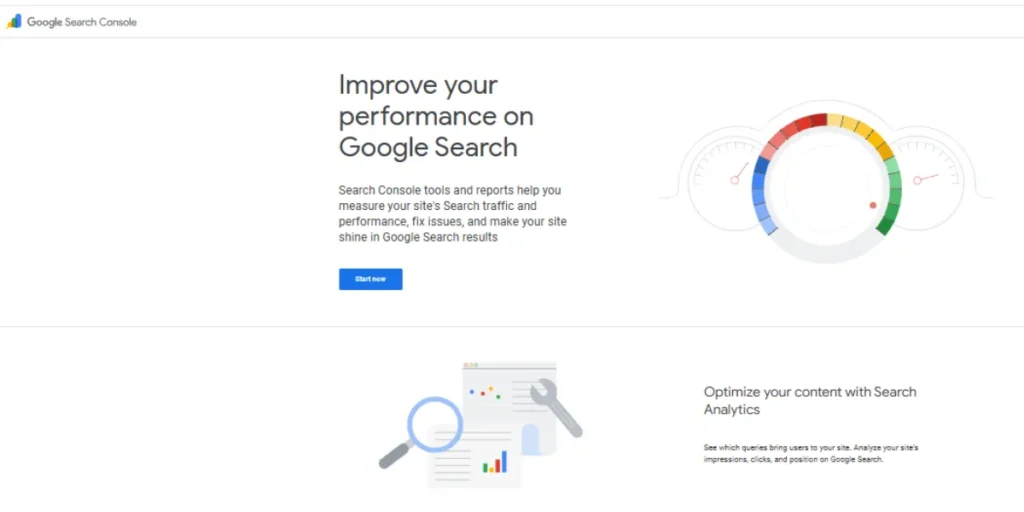
Google Search Console is the core free utility that any website owner must have. It gives you first-hand data on the performance of your site in search at Google in the form of impressions, clicks, average position and CTR on each query that your site appears to answer.
The platform provides 16 months of past data, which enables you to view trends and determine opportunities and learn how Google views your content. It is especially useful as it demonstrates real data of search performance and not estimations.
- What it does for forecasting: It gives us the historical performance information and also identifies the trending queries that can be used in anticipating future traffic opportunities.
- Who it’s best for: Designed to be used by the website owners and those who are still new to SEO and would like to get the exact information (direct) on Google without paying any fee to Google.
- Why it’s good: Provides real Google search data without estimations and approximations of a third party.
Pricing: Fully free with nothing to restrict the data access or the features.
Website Link: https://search.google.com/search-console/about
2. Google Trends
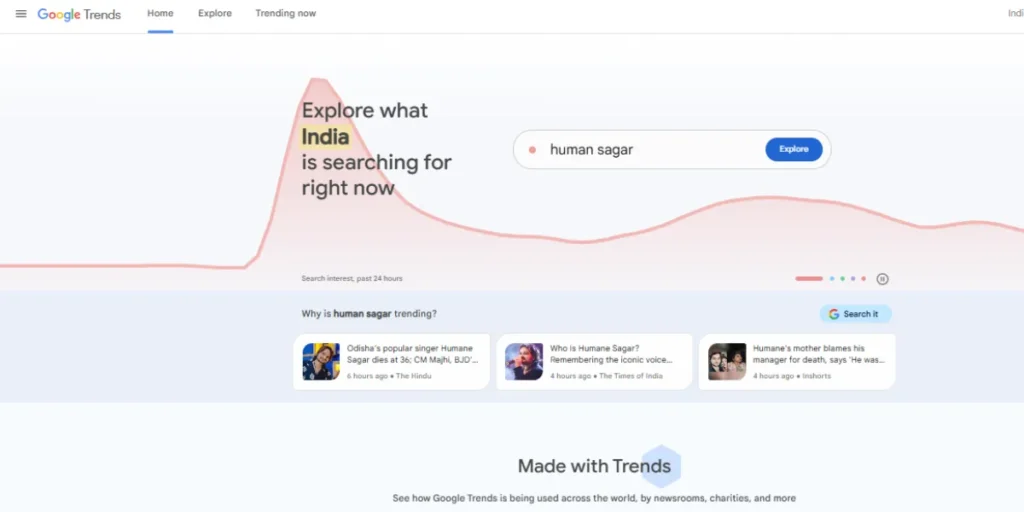
The next free tool is Google Trends, which informs about the relative popularity of search terms over time. It will assist you in knowing the trends of the season, the emerging trends, and the disappearance of the interest in the topic in various regions and at different times.
Comparing a number of keywords, one will be able to determine what is becoming popular and what is becoming unpopular. The tool is invaluable in planning content and knowing the demand of the market without spending resources in optimisation activities.
- What it does for forecasting: Helps to predict future demand of the topic and keywords because it can show the trends of search interest and seasonal trends.
- Who it’s best for: Content strategists and marketers who are strategising seasonal campaigns or where they see an opportunity to keep abreast with the emerging trends.
- Why it’s good: Displays real-time trend information and past trends that can be used to make predictions about changes in content demand.
Pricing: Free tool with other searches and comparisons being unlimited and available to any user across the world.
Website Link: https://trends.google.com/trends/
3. ZISSOU’s Free SEO Forecasting Tool
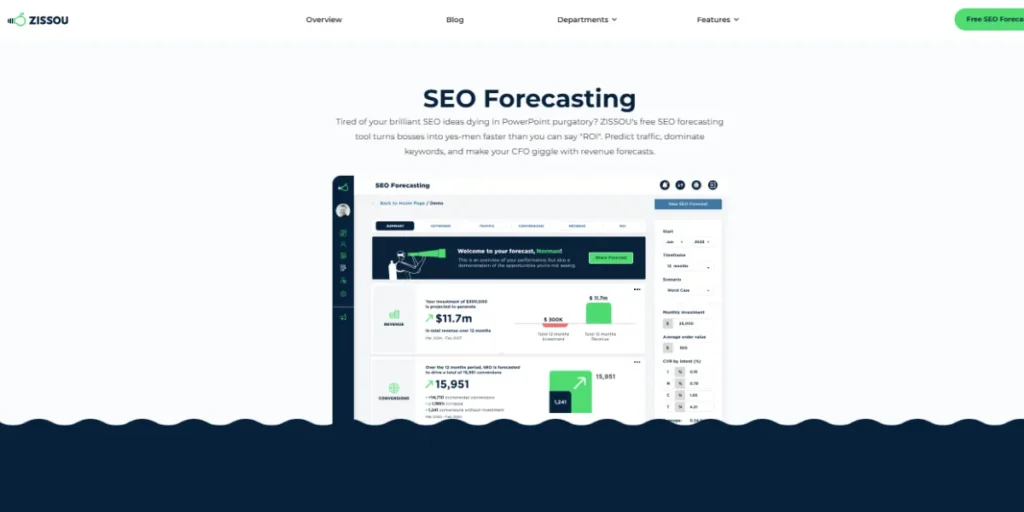
ZISSOU provides simple, easy SEO forecasting tools that target agencies and in-house teams in need of fast projections that do not require complicated installation. With this tool, you can submit the existing traffic data, average position and forecasted improvement to come up with the traffic forecasts.
It also comes in handy, especially when providing possible outcomes to clients during proposing or planning quarterly strategies. The interface is user-friendly, and advanced forecasting can be easily availed even to users who lack knowledge of statistics.
- What it does for forecasting: Copes with the potential traffic increases dependent on the ranking of improvements and historical CTR figures in relationship to forecasts.
- Who it’s best for: Agencies that are submitting bids and teams that require rapid traffic estimates forclient-reporting purposes.
- Why it’s good: easy interface and no learning curve; immediate forecasting results in a few minutes.
Pricing: No sign-up and free to use, which is ideal when one wants to perform rapid analyses.
Website Link: https://zissou.pacific.co/features/seo-forecasting
4. Digital SnowStorm
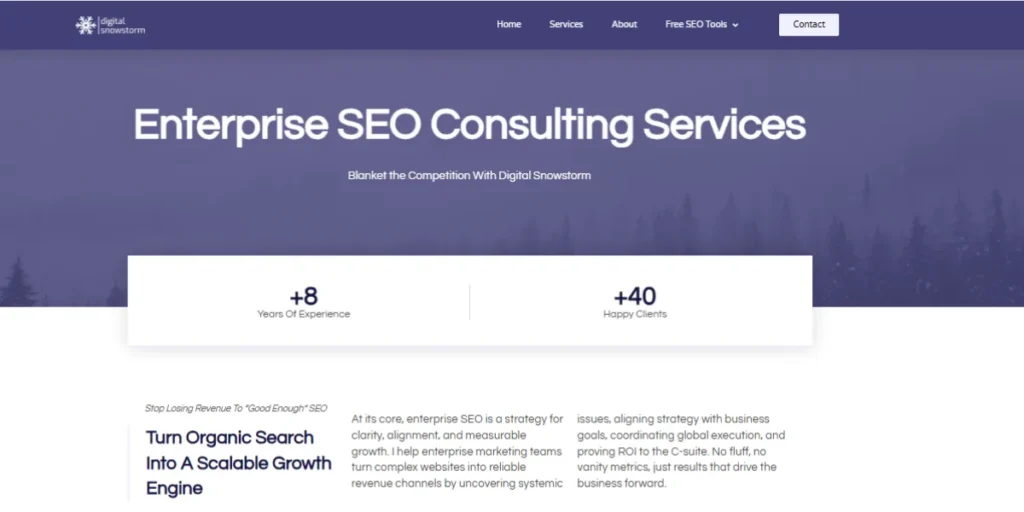
Digital SnowStorm is a detailed free SEO Forecasting Tools that is an integration of several forecasting techniques. It enables you to post Google search console and Google analytics data and uses statistical models to forecast the future performance. The tool takes into account such elements as current rankings, volume of search, CTR curves and previous growth rates.
Its distinguishing feature is the possibility to model various conservative, moderate, and aggressive situations to reveal the picture of possible results instead of one forecast.
- What it does for forecasting: Generates conservative, moderate and aggressive traffic forecast scenarios with the aid of multiple statistical models.
- Who it’s best for: suited to SEO professionals with multi-scenario, statistically rigorous, and available forecasts.
- Why it’s good: It offers end-to-end scenario planning that has an open methodology that is understandable and credible to the stakeholders.
Pricing: Free tier available with basic forecasting features, with premium options for advanced analytics.
Website Link: https://digitalsnowstorm.com
Top Paid SEO Forecasting Tools
5. Advanced Web Ranking
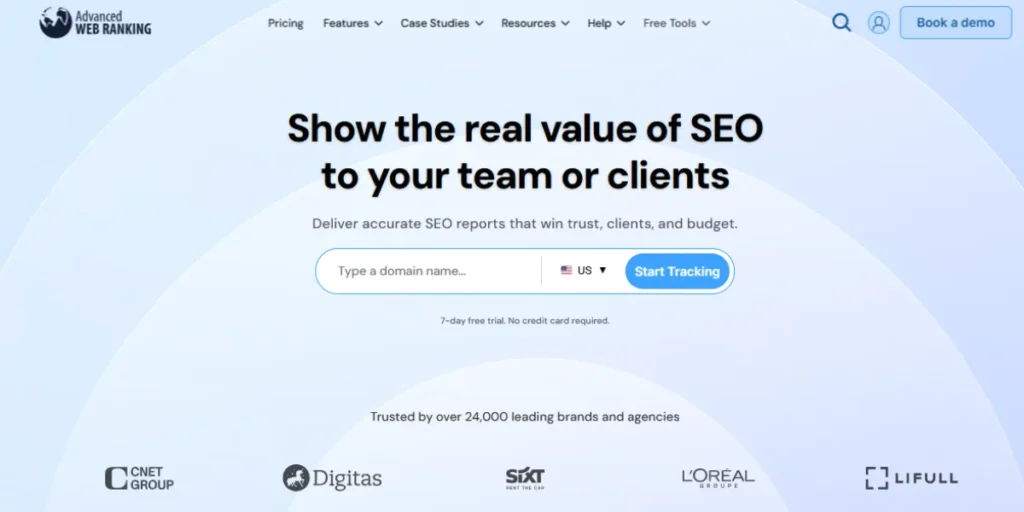
Advanced Web Ranking is the full-fledged rank tracking and anticipation tool used by agencies and businesses universally. It also monitors unlimited keywords in various search engines and regions in offerings that offer fine-tuning of changing ranking. Its forecasting features use several years of past rates to forecast the changes in the traffic according to the ranking movements.
It gets its white-label reporting capabilities, which are ideal when an agency has to deliver professional foretellings to its clients using branded resources and dashboards.
- What it does for forecasting: follows the rankings of the keywords being tracked and extrapolates on the changes in the position and the past trends on traffic.
- Who it’s best for: Agencies with several clients requiring white label reporting and the ability to do rank tracking.
- Why it’s good: Provides unlimited tracking and local and mobile rankings with accurate information for any keyword on any device.
Pricing: Plans begin at $49/month, with the pricing divided in tiers depending on the number of keywords tracked and the functionality requirements.
Website Link: https://www.advancedwebranking.com
Also read : What is White Label seo and benefits
6. SEO Clarity
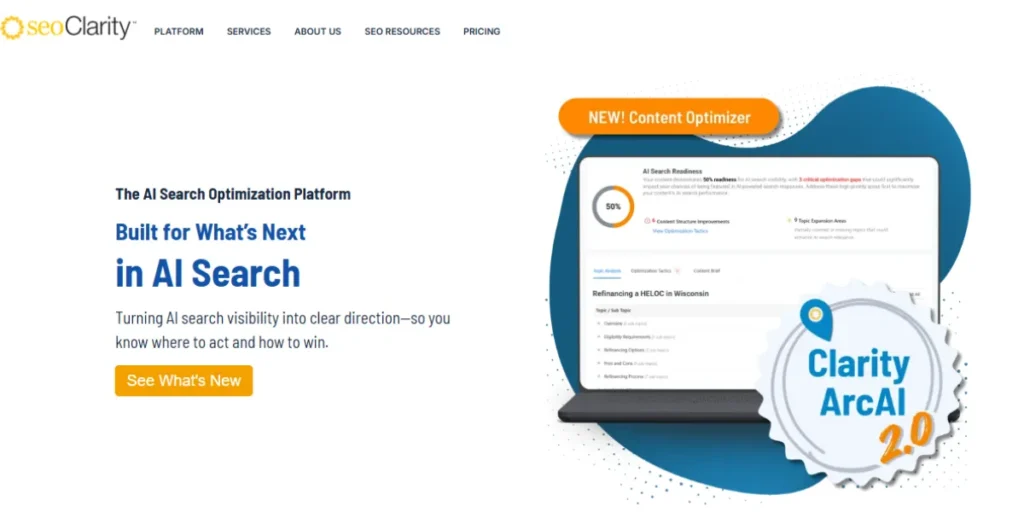
SEOClarity is an SEO foreshadowing instrument of enterprise grade adorned with artificial intelligence and all-encompassing seo data. The platform proposes content optimization suggestions, technical auditing, and advanced forecasting frameworks likely to project traffic on thousands of keywords at a time.
Its machine learning methods examine past trends, seasonal changes and competitive forces to come up with most accurate estimations. It works with Google Analytics and Search Console, whereby a single view of your SEO performance and potential can be seen.
- What it does for forecasting: It uses AI-based algorithms to make predictions with accuracy on traffic potential on whole portfolios of keywords.
- Who it’s best for: Enterprise companies that run massive SEO initiatives which span several websites and cross-national markets.
- Why it’s good: Has the best data coverage and machine learning-based insights to enhance the accuracy of predictions over time.
Pricing: Community-orientated enterprise pricing is provided around website size, functionalities needed, and user base.
Website Link: https://www.seoclarity.net
7. Ahrefs
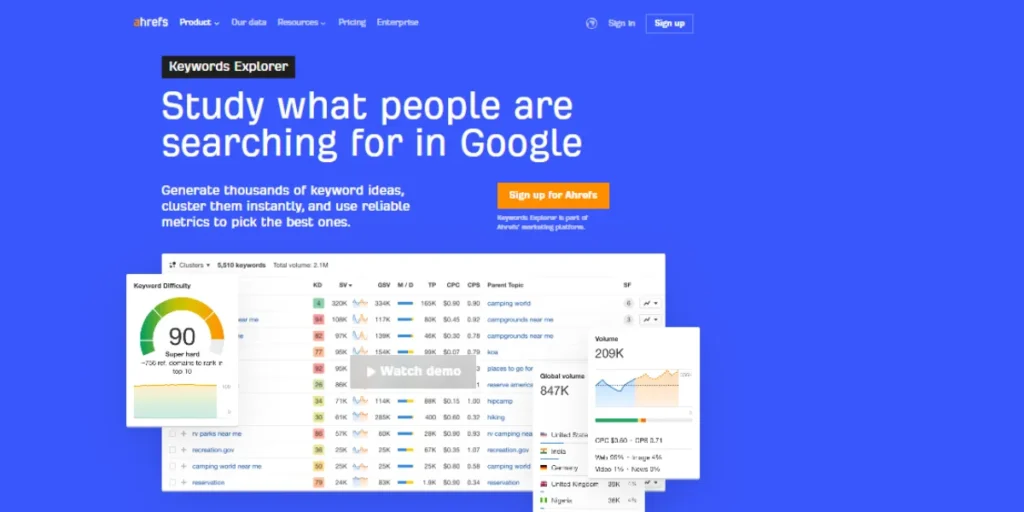
The name Ahrefs is one of the most reputable resources in the area of SEO, which is capable of providing a host of backlinks, keywords and competitor intelligence. Although the site is famous mostly due to the backlink analysis service, Ahrefs is also known as a rather strong forecaster using its Keywords Explorer and Site Explorer tools.
You are able to profile the keyword difficulty, search volume dynamics and the ability to get traffic to any page or domain. In the Traffic Value, the platform estimates the value of organic traffic to assist you in focusing on the opportunity with the best revenue potential to your business.
- What it does for forecasting: Provides traffic potential and value estimates of keywords based on searching a large volume of search data and ranking.
- Who it’s best for: Search engine optimisation specialists who are performing competitive research and keyword research to aid in strategic planning.
Pricing: High-quality backlink search database and correct metrics of keyword difficulty that are available in the industry.
Website Link: https://ahrefs.com/keywords-explorer
8. Semrush
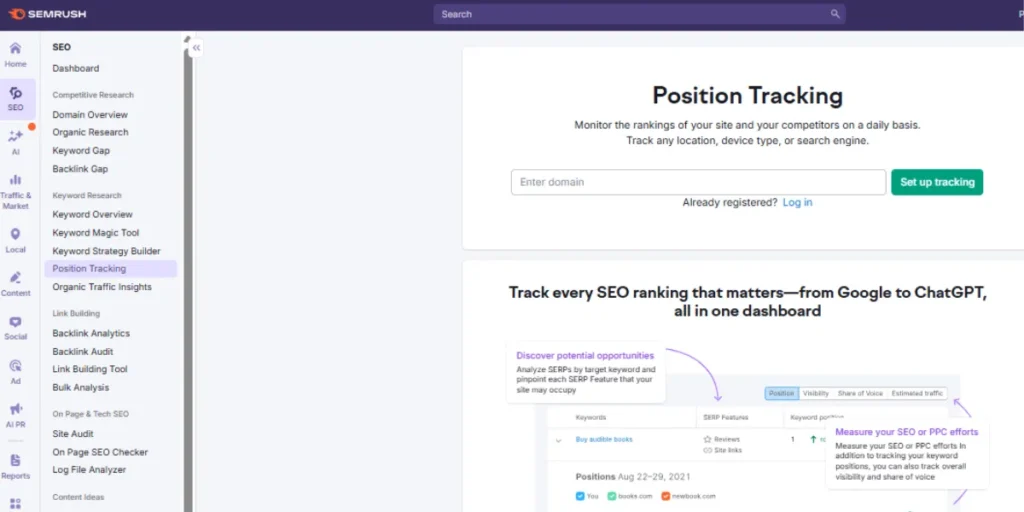
Semrush is a completive marketing system that is now the SEO prognosticator of the millions of marketers all around the world. Its Position Tracking feature follows up on changes in ranking daily and predicts the traffic according to the SERP movements. The special Traffic Analytics tool of the platform makes it possible to approximate the traffic of competitors and invert-engineer their success.
Semrush offers unparalleled visibility on search opportunities with more than 25 billion search engine queries in its database. The ImpactHero functionality specifically points out the pages and the keywords that will give the most appreciable increases in traffic.
- What it does for forecasting: organic traffic is projected using the analysis of keywords, search volume and competitive analysis.
- Who it’s best for: suited to the needs of digital marketers who require an all-in-one solution to SEO, PPC, content and competitive intelligence.
- Why it’s good: There is a large competitive intelligence available up to any level provided by a vast array of keywords in the SEO world.
Pricing: Plans begin at 139.95/month with various features depending on project constraints.
Website Link: https://www.semrush.com/position-tracking/
9. SuiteJar
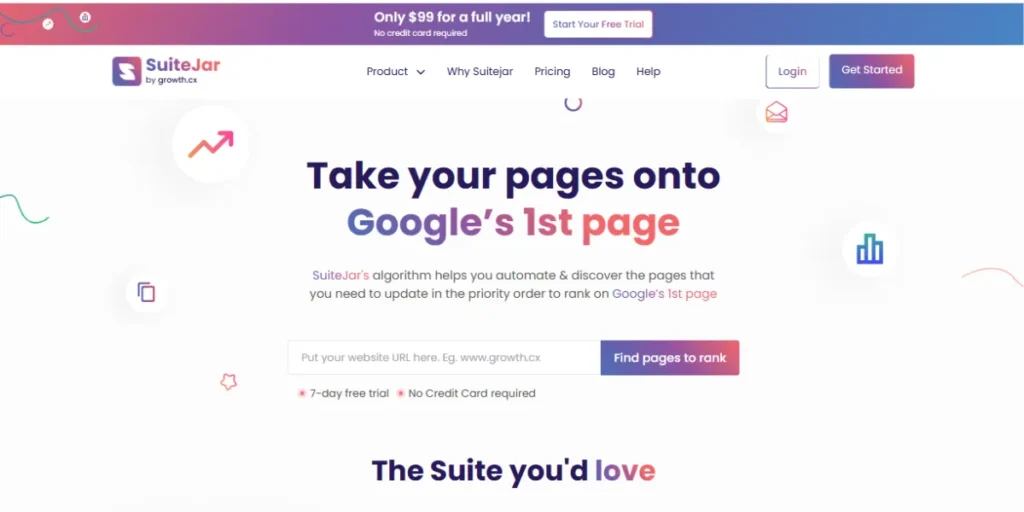
SuiteJar is an SEO forecasting company that is centred on data presentation in a manner comprehensible to executives and other stakeholders. This seo forecasting tool helps simplify statistical models that are too complicated and you cannot easily understand and take action. It can easily work with Google Analytics and Search Console and can automatically import all your previous data to forecast.
The platform is the best in terms of modeling the scenario of what-ifs, as specific stakeholders can be shown by the impact that various investments in SEO will have prior to any resources being allocated to a particular strategy.
- What it does for forecasting: generates stakeholder-friendly forecasts which convert the measures of SEO to business impacts and revenue projections.
- Who it’s best for: SEO managers who must present complicated forecasts to the executives and other non-technical stakeholders.
- Why it’s good: it turns technical data on SEO into understandable business language to implement strategic business actions.
Pricing: Custom pricing according to business size, as well as forecasting requirements with a demo.
Website Link: https://suitejar.com
10. Serpstat
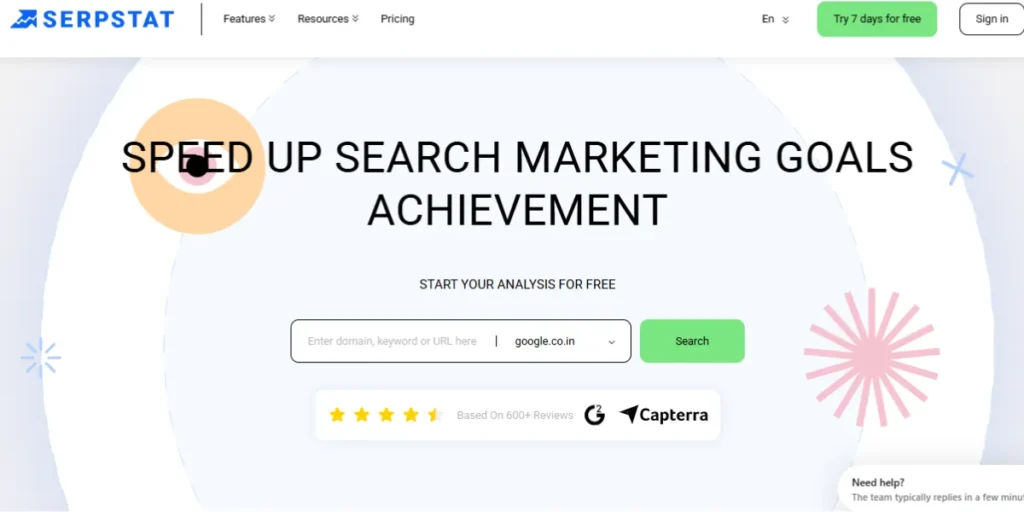
Serpstat is a growth hacking tool that integrates his SEO, PPC, and content marketing tools in a single low-cost pocket. Its forecasting capabilities are aimed at finding quick wins keywords on which small ranking gains can be turned to a great amount of traffic growth.
Missing Keywords tool in the platform helps to identify holes in your content strategy by charting your positions with those of competitors. Serpstat allows an international SEO Forecasting Tools with data on 230 countries, which are fundamental to businesses entering the new markets, or using multilingual websites.
- What it does for forecasting: Determines the missing opportunities of the keywords and the potential traffic through an expansion move to the international market.
- Who it’s best for: A start-up and expanding business that requires low-cost, full-service SEO tools with the ability to operate internationally.
- Why it’s good: It is exceptionally good with complete features at much lower prices in comparison to the competitors.
Prices: The plans begin with 69/month with large keyword and project quotas.
Website Link: https://serpstat.com
11. Moz Pro
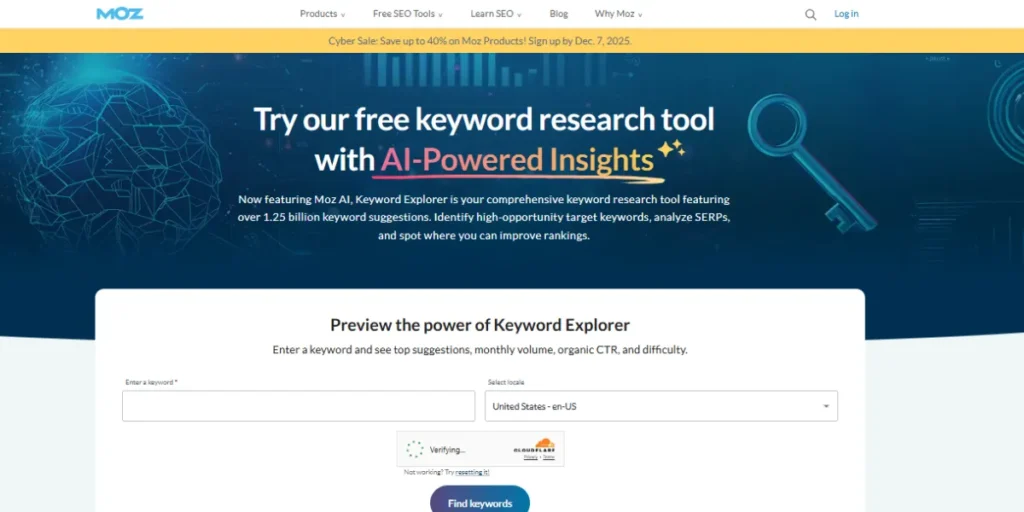
Moz Pro warrants a strong reputation in the SEO industry since its establishment, as one of the more dependable tools with years of research supporting the claims. The Keyword Explorer supports the platform with correct data on the search volume and SERP analysis, whereas Rank Tracker tracks the position change of thousands of keywords.
The proprietary tools that Moz has developed such as Domain Authority and Page Authority are now internationally recognised as the metrics of ranking potential. The forecasting functionality of the platform is based on these metrics to forecast your rapid ability to rank a target keyword based on your current site authority.
- What it does for forecasting: Predicts ranking by the proprietary metrics of authority and historical pattern of difficulty of keywords.
- Who it’s best for:The SEO professionals who prioritize data backed by research and credible information of a trusted source in the industry.
- Why it’s good: It contains clear, research-backed metrics with which the SEO community has long been familiar.
Pricing: The price starts at 99/month with many levels depending on campaigns and keywords monitored.
Website Link: https://moz.com/products/pro/keyword-explorer
12. SpyFu
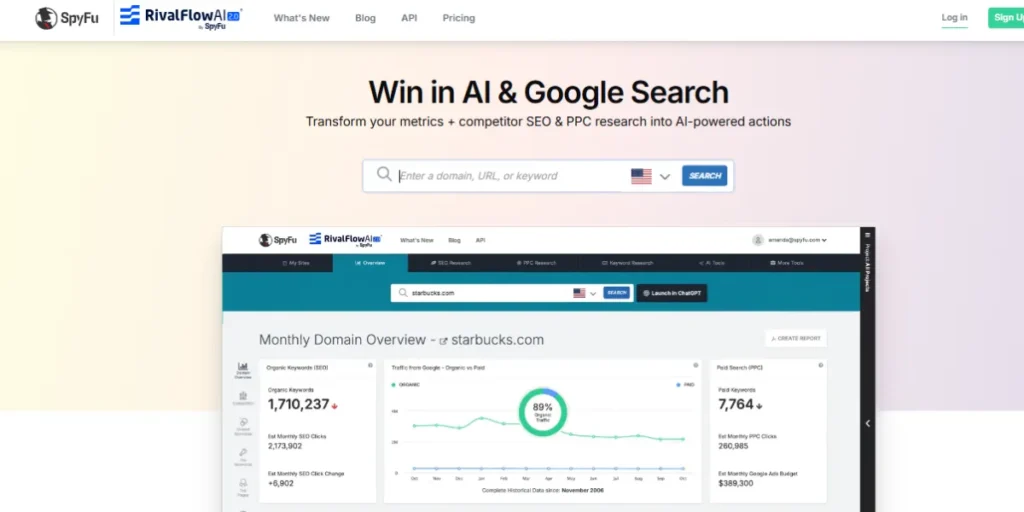
The approach used by SpyFu to make predictions with regard to SEO is the competitive intelligence, which gives you a chance of identifying all the keywords that your competitors have ranked during the last 17 years. This view of history is priceless in prognostication since you can determine the seasonal trends, winning content plans, and keyword opportunities that your market rivals have already tested.
The Kombat tool of the platform shows the gaps in your keywords when your rivals are ranked higher, and you are not, which will give you a guide on what to write about. The data integration of PPC offered by SpyFu can also be used to forecast paid search prices in addition to organic opportunities.
- What it does for forecasting: It will display competitor keyword history and estimate the value of traffic to help identify the proven opportunities.
- Who it’s best for: Competitive researchers and companies operating in a saturated market and require strategic intelligence as a way of differentiation.
- Why it’s good: Provides unparalleled historical competitor data based on more than 17 years of search performance history.
Pricing: Plans are priced at $39/month, and it is one of the cheapest enterprise-level plans.
Website Link: https://www.spyfu.com
13. SEO Monitor

SEO monitor has been created with agencies that handle SEO campaigns on a large scale in mind. This seo forecasting software would automatically forecast the individual clients using their specific industry, competition and performance track record. The goal-focused forecasting approach of the platform, which has the advantage of linking SEO indicators to the business results, makes it simpler to prove its value.
Automated reporting offered by SEO Monitor will save agencies millions of hours and make clients have professional, uninterrupted updates. The tool also monitors changes in the algorithm and their effect on the forecaster.
- What it does for forecasting: Automates the client specific forecasting on the basis of industry benchmark and objective campaign planning methods.
- Who it’s best for: SEO firms that operate on behalf of numerous clients who require automated and precise forecasts to report.
- Why it’s good: Designed solely by the agencies with functions that facilitate the client management and reporting processes.
Pricing: Custom agency pricing depending on the number of clients and features needed.
Website Link: https://www.seomonitor.com
14. HeyBooster
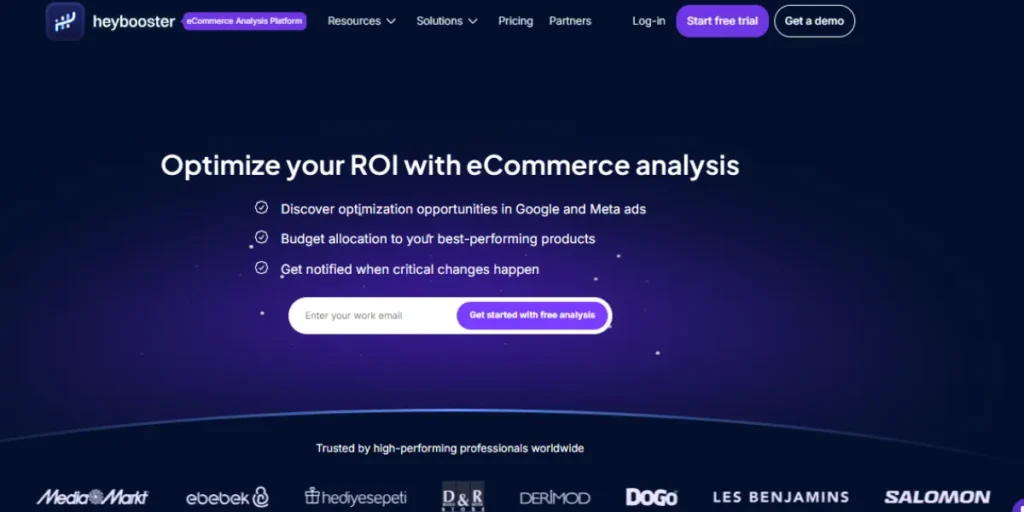
HeyBooster is an AI-based SEO Forecasting Tools that is used to predict results and opportunities, based on the analysis of your Google Analytics and Search Consoles data in the most automated manner. However, unlike conventional tools, HeyBooster will automatically alert about ranking changes, traffic anomalies, and forecast changes.
Predictions are enhanced with machine learning over time, and it learns the specific patterns of your site. The complex data is available to the team members who otherwise lack expertise in SEO using its natural language capabilities, making the process of data-driven decision making more democratic.
- What it does for forecasting: For the forecasting AI is used to automatically detect opportunities and forecast traffic variations without manually setting up configurations.
- Who it’s best for: Busy marketers eager to have automated information and forecasts that are provided on a regular basis without having to be present all the time.
- Why it’s good: Easel out of the door – will automatically uncover the most notable insights and actionable opportunities, eliminating the need to conduct the manual analysis.
Pricing: The plans begin with a base of $49/month with tiered based pricing depending on the amount of traffic to the site.
Website Link: https://heybooster.ai
How to Do SEO Forecasting: Step-by-Step Guide
Step 1: Gather Historical Data
- At least 12 months of data will be exported in Google Search Console, such as clicks, impressions, CRR and average position.
- Get Google Analytics statistics that reflect the number of organic sessions, the bounce rate and conversion figures over the same time.
- Record all significant changes in the algorithms and changes to the sites or marketing campaigns that influenced the traffic within this period.
Step 2: Find Your Target Keywords.
- Make a list of the keywords that you are already ranking on and would like to improve with the help of rank trackers.
- Identify new keyword opportunities with the help of such tools as Ahrefs, Semrush or Google Keyword Planner.
- Focus on strategic focus on keywords by prioritisingthe level of search, difficulty and business value.
Step 3: Current Rankings and CTR Analysis.
- Record your present average ranking of every target keyword on search results.
- Compare your real CTR with industry standards of each position in order to see where improvement is possible.
- Collect keywords on which you appear on page two (11-20) as quick-win candidates.
Step 4: Establish Attainable Goals of Improving Ranking.
- Decide which number of positions you are able to optimise every quarter depending on the difficulty of the keywords.
- When establishing expectations, consider the area of your authority, quality of content, and competition.
- This is to enter with conservative estimates of competitive keywords and slightly aggressive goals of low-competition keywords.
Step 5: Estimate Possible Traffic Growth.
- Search industry best CTR curves in every target position in your portfolio of keywords.
- Times the number of expected clicks per search volume per keyword to find out the total amount of traffic.
- Take into account seasonal considerations and make revisions in the months that have a record of high or laggard demand.
Step 6: Take into account conversion rates.
- Use your existing organic conversion rates on projections of traffic to forecast revenues.
- Segment with the intent of the keywords (informational, navigational and transactional) because the rates of conversion differ greatly.
- But make conversion projection changes when you are enhancing landing pages or user experience as well as rankings.
Step 7: Develop Several Scenarios.
- Create a scenario of conservative, moderate, and aggressive forecasts to cover up any uncertainty.
- Conservative: insignificant scoring changes, reduced assumptions on CTR, possible disturbances of the algorithms.
- Aggressive: Best ranking growth, elevated CTR, excellent market circumstances and trends.
Step 8: Validate and Refine
- Compare your predictions to historical growth trends to make sure that they are reasonable and correct.
- The model would be tested every month and praised or rebelled by modifications of assumptions regarding actual performance and predictions.
- Hone your methodology with experience as you get more and more data and insights about your site peculiarities.
Common Challenges & Pitfalls in SEO Forecasting Tools
- Updates to the Algorithms: Google is known to have unpredictable algorithm updates which can drastically change the ranks overnight, making it impossible to predict anything, irrespective of how one does it.
- Seasonal Fluctuations: When seasons are not taken into account, the tendency is to overpromise in slow months and underestimate peak seasons.
- Competitive Actions: Competitor SEO activities, content creation or link development have the potential to alter the competitive environment in an unpredictable way.
- Unrealistic Projections: This is a result of undue pressure to produce spectacular outcomes which become invalid when negative.
- Inadequate Historical Data: Forecasting that is conducted involving less than 12 months of the past does not reflect seasonal patterns and cyclical trends.
Best Practices & Tips for SEO Forecasting Tools
- Revise Forecasts on a regular basis: review and revise projections on a monthly basis due to actual performance to ensure accuracy and engagement of stakeholders.
- Cease Guesswork: Never give precise numbers in forecasting, but always give a range to show the right expectations to the stakeholders.
- Document Assumptions: It is important to clearly mark all the assumptions under which you make your forecasts so that the same could be revised when conditions change.
- Integrate a number of Tools: Cross-verify predictions using several forecasting tools and methods to find outliers.
- Add Confidence Intervals: Statistical confidence limits assist the stakeholders in knowing the probability of various results occurring.
- Account for Cannibalization: The idea here is to know when predicting new content that it may cannibalize the traffic on existing pages.
- Train Stakeholders: Educate those members of the non-SEO team who do not recall that projections of forecasts are probabilities rather than assured outcomes.
Conclusion
SEO forecasting has grown out of guesswork into an advanced, data-driven practice that is a necessity in modern digital marketing success. It does not matter whether you use a free SEO forecasting tool such as Google Search Console or spend money on such services as Semrush or Ahrefs; it remains the regular use and constant improvement. The methods and instruments described in this guide will give you a basis of making precise predictions that will guide you to making strategic safe budgets and to harmonise anticipations within your organisation.
Also keep in mind that forecasting is an art and science – use good data analysis with knowledge of the industry and realistic assumptions. With the potential of the search algorithms becoming more advanced and the user behaviour further developing, individuals who learn how to predict search engines will have a significant competitive edge.
FAQs
How accurate are SEO forecasting tools?
The accuracy of most quality SEO forecasting tool platforms in the case of adequate historical data availability and consideration of the seasonal trends is 70-85%. The precision is enhanced as time passes, models get to learn about the peculiarities of your site, and you narrow assumptions on the basis of actual results.
How far ahead should I forecast SEO traffic?
A majority of the professionals suggest that the tactical planning takes 3-6 months of forecasts, whereas strategic initiatives should take 12 months. The future views of longer projections are more uncertain because of a change in the algorithms, competition and changes in the market which are not easy to project.
Can I forecast SEO for a brand new website?
Yes, with less confidence. Estimate potential using industry benchmarks, competitor analysis and keyword difficulty measures. Begin with estimates that are conservative, and when you come to a 3-6 month time when you have real performance data, update it.
What’s the difference between free and paid forecasting tools?
Free tools only offer simple historical analysis and trends although they need to be computed manually. Paid tools provide advanced statistical models, automation, competitive intelligence, as well as precision in scenario planning that is very time-saving and accurate.
How do I forecast SEO impact when changing website architecture?
Examine comparable moves in the past in your business, apply low values of retention of traffic (80-90%), and simulate the slow recovery in 3-6 months. Every time, develop best-case, worst-case and likely scenarios of significant technical changes that may affect rankings.



